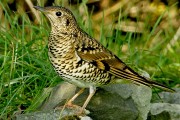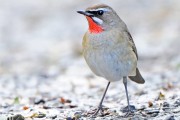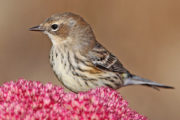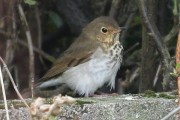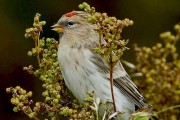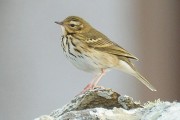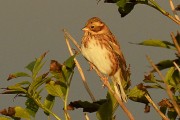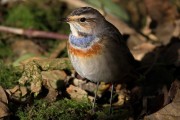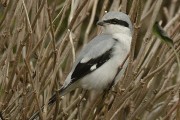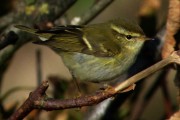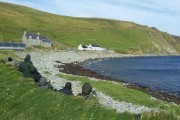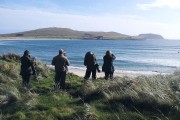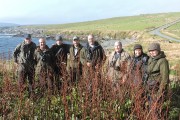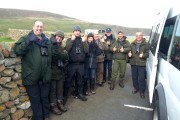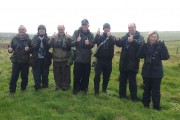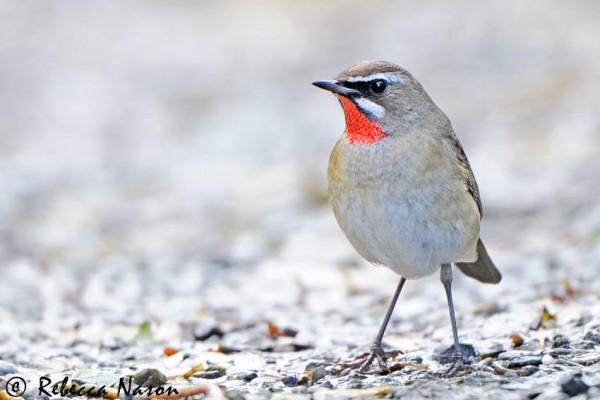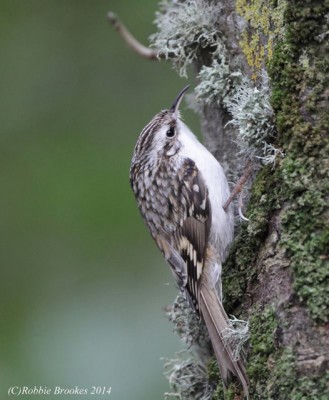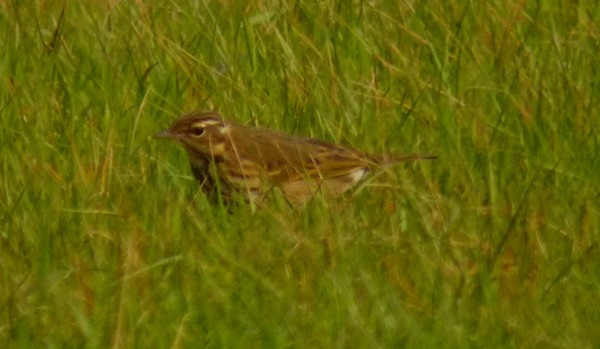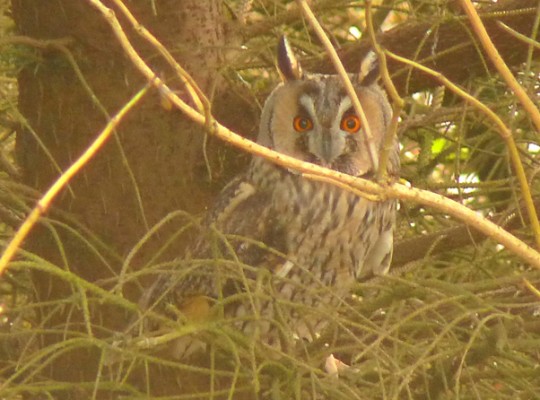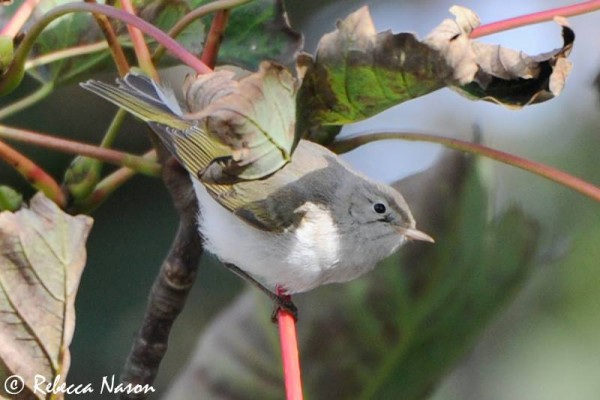Shetland Autumn Birding 2014
Posted by Brydon Thomason on Wednesday 7th January 2015 | Birding in Shetland
Reviews from our 2014 autumn itineraries by leader, Chris Rodger
Some superb and very exciting birding for all our guests on the Shetland Autumn Birding itineraries which sold out all spaces, highlighting just how special, popular and widely known Shetland in autumn is now known to be. It’s fantastic to see that each year these itineraries become more popular and each year – the birds continue to deliver through the megas that turn up.
Over this period there were some superb quality headliners such as Swainson’s and Whites Thrush, Siberian Rubythroat and Yellow-rumpeded Warbler along with a fantastic supporting cast of rare, scarce and common migrants. As well as these and as we hope and aim for in these itineraries there was also some exiting team effort discoveries along the way such as Olive-backed Pipit, Pectoral Sandpiper and not to mention the Firecrest- which in a local context was a mega- a first for Unst! Great birds, great guests and great fun- here’s a review from Chris Rodger….
Guest Quote
Hi Brydon – just a quick email to say a massive thank you for an awesome birding holiday. I thoroughly enjoyed working lots of habitat trying to and finding our own birds. Chris was a fantastic guide and as you know put us onto all the ‘long stayers’ . His knowledge and field skills were superb and he constantly worked to keep everyone happy – no easy task at any time but especially more difficult as we had a broad range of birders with wide ranging knowledge and skills. I certainly hope to return for more of the same… I’ll be trying to plan next year’s work in order to get back up with Shetland nature.Andy Williams
An amazing day….the Whites Thrush alone was worth the cost of the entire trip and then there was the Yellow-rumped Warbler! Two mega rarities within an hour! What more could a birder want?!Andrew Riley
Week One 26 September – 3 October 2014 – in association with Birdwatch magazine
Day One
The first morning’s birding on South Mainland provided opportunity to introduce the group to the ‘art’ of team birding on Shetland. The tactics adopted when checking suitable crops, iris beds, nettles, thistles, ditches and gardens were practised and a wide variety of ‘pishes and clicks’ were experimented with. Several skulking common migrants were manoeuvred into revealing themselves and it was clear that the team were ready to throw themselves into a week of migrant birding on Shetland!
A highlight of the day was a Hornemann’s arctic redpoll at Veensgarth. Although not a classic ‘snowball’, the bird displayed the key arctic redpoll i.d. features well for the group. It was accompanied by 3 indeterminate ‘mealy-type’ redpolls, allowing the group to enjoy the inevitable discussion on the intricacies’ of redpoll identification. Nearby, red-breasted and pied flycatcher were also seen. A couple of stops on the journey through to Unst provided another each of red-breasted and pied flycatcher, barred warbler and brambling.
Day Two
Following breakfast, a barred warbler put on a fine display, hopping along the Hotel wall as the group boarded the minibus. A grand start to the day, but little did we know that things would only get better, as today we were to experience the best Autumn birding Shetland can offer. The morning in Baltasound produced two quality birds, with excellent views of a smart male Eastern subalpine warbler followed by a long-staying but often elusive rustic bunting at Halligarth, which Brydon ensured was tracked down for the group to see at close quarters. Moving northwards through the island, a stop at Haroldswick allowed the group to enjoy a Temminck’s stint, before settling down to a peaceful lunch whilst watching a wryneck feeding on the seaweed-strewn beach at Norwick. However, this tranquil scene was quickly shattered with news that a Swainson’s thrush had been found just 500m away! Sandwiches discarded, a farcical few minutes followed as the bird fed behind a fence rail, above which only the two tallest members of the group were able to see. Attempts at piggy-backs and climbing onto the minibus to obtain views proved fruitless! Thankfully, the bird flew on to the garden wall and everyone managed crippling views of the nearctic mega – a lifer for the whole team. The remainder of the day had the team find a common rosefinch and a further two barred warblers amongst a selection of commoner migrants such a lesser whitethroat and whinchat.
Day Three
Today the team again birded around Baltasound in the morning, returning to see the subalp and rustic again, because they were so good! A pleasant mornings birding included a very obliging bluethroat, three more barred warblers, yellow-browed warbler and jack snipe. Fine views of otter feeding rounded the morning off nicely.
In the morning the north end of the Unst appeared to be well covered by other crews, so we decided to explore the lesser-known birding spots in the south of the island. Working these sites produced a few common migrants including yellow-browed warbler and lesser whitethroat, as well as some classic Shetland scenes, such as large flocks of linties (twite) in the neep fields and an amazingly confiding otter on a secluded beach.
A team challenge was set when we arrived at the thistles at Lund. Here, the team were presented with an ‘unstreaked acro sp.’, which they were tasked with identifying amongst themselves (mainly for educational reasons, but partly out of mischief on the part of the group leader). Through careful observation and assimilation of the key features, the group did extremely well at arriving to the correct conclusion that they were observing a first-year marsh warbler. An impressive identification of a very tricky species.
Meanwhile, in the south of Shetland, the big news was the double-header finding of two mega’s; yellow-rumped warbler (relocated after a frustrating brief appearance) and White’s thrush; a classic Shetland ‘East meets West’ scenario.
Day Four
Despite the presence of two Mega’s at the opposite end of Shetland, it is a credit to the team that after a group discussion the decision was to stick with the plan to visit Fetlar, rather than twitch the length of the archipelago- with the plan to go on news next day. The philosophy of ‘if those birds are turning up down there, imagine what we could find up here?’ is indeed admirable. However, despite scouring virtually every iris bed, ditch and willow on the island, we could only reply with a couple of yellow-browed’s amongst the commoner migrants. The team’s efforts were gallant indeed, and a reminder that, despite how it may appear to birders from afar, rarity finding on Shetland involves considerable hard graft, sometimes with scant rewards.
Day Five
With news that both the White’s thrush and yellow-rumped warbler had remained on South mainland, coupled with being shown endless photos and video of the birds by the ecstatic birders who had made the journey – relief, optimism and excitement levels peaked: the twitch was on!
Anticipation rose with every one of the 77 miles and two-ferry journeys down the Shetland chain and the excitement was at fever pitch when we arrived outside the garden where the White’s thrush had settled. From a personal point of view, seeing this iconic ‘sibe’ for the first time exceeded already sky-high expectations; it was simply stunning and one of the most overwhelming birds I have ever seen. Judging by the reaction of the team, the bird elicited similar emotions!
Next stop was for the YRWarbler, which gave fantastic views as it busily fed amongst the attractive flowerbeds of the Grutness garden. Cracking views of a yank and a sibe in a morning; as a certain well-known birder would say – BOOM!
Day Six
The final day was spent stopping at various sites on Yell and mainland on our way to the hotel at Spiggie. A good selection of common migrants were seen, with a few new birds for the trip to bring the total to 92 species. Whilst a relatively modest in terms of species diversity, the total included five BB’s and a whopping 46 lifers between the seven experienced birders on the trip. Not bad for a week of westerlies, and the team were all ecstatic with week’s haul.
News breaking of the Siberian rubythroat at Levenwick was however well beyond the possibilities to connect as guests were already on route to destinations south (all but one – a certain Mr Andrew Dodd who was staying with us for week two!). On the bright side, it arrived just in time to give Shetland Nature’s next cohort of Autumn birders the dream start to their Shetland adventure.
Week Two – 4th to 11th October
Day One
Could you wish for a better start to the week?- perhaps the most iconic and sought-after of all Eastern vagrants, a fine male Siberian rubythroat! Not surprisingly we strted the tour started ahead of the scheduled 6p.m. start to ensure that our guests had the dream start to their trip.
The group were met as they arrived by plane and boat throughout the day and expediently transported to the garden at Levenwick where this ‘sibe’ beauty was hopefully present for its second day. Oh were it so simple! With no sightings of the bird since 8 a.m., as the hours passed we became increasingly resigned to the prospect of a crushing dip. At around 4p.m. we were literally conceding defeat and heading back to the minibus when suddenly there came a shout from a nearby garden! After a mad dash and a wait that felt much longer than it really was, the bird hopped across the driveway for all the group to see! Ecstatic gasps came from the admiring crowd when the rubythroat turned full-front and revealed it’s brilliant the scarlet throat and black and white face mask. Stunning!
Day Two
The team this week possessed extensive experience of Autumn birding on Shetland, including several Shetland Nature regulars, so we threw ourselves into ‘working’ Geosetter, a challenging ‘forest’ of cover by Shetland standards. Here we found our first two yellow-browed warblers of the trip and a fine pied flycatcher. There was plenty of wildfowl to be seen on Loch of Spiggie, including splendid views of slavonian grebe and scaup, with an evocative soundtrack provided by the excited trumpeting of many newly-arrived whooper swans. Next stop was Quendale, where there were good numbers of thrushes, goldcrest and blackcap along with a whinchat and a good ol’ scrap between a kestrel and merlin.
As we headed northwards towards our destination of Unst, a stop at Helendale provided another yellow-browed warbler.
Day Three
Although today didn’t provide any major rarities, it was a classic example of the excitement of seeing migrants making a massed landfall, literally all around us, as we birded the northern half of Unst. The drama was provided by a Force 10 southeasterly gale and heavy rain; whilst not the most comfortable of conditions, the weather conspired to produce a very tangible migration event, which makes migrant birding on Shetland so special.
After a brief stop for a grasshopper warbler, our first destination was Skaw, Britains most northerly beach. On arrival, there were relatively modest numbers of migrants, mainly goldcrest and redwing. However, as soon as the rain started, it became clear that goldcrest were falling out of the sky all around us, so much so that they were flying up from under our feet. As the morning went on, we continued to experience this mass arrival, including large numbers of song thrush, redwing and chiffchaff. A memorable sight was a newly-arrived yellow-browed warbler feeding among seaweed next to a long-staying wryneck.
After a mid-morning break, to dry off a bit, we went back out to sift through migrants as they moved ‘down-island’ to the more substantial areas of cover around Baltasound. A treecreeper had been reported from the mature sycamores of Halligarth, but not seen subsequently, despite much searching. It was Jim from our group who managed to relocate the bird, and the impression of a treecreeper he adopted to signal his find was truly memorable! The treecreeper, of the nominate ‘Northern’ form (C.f. familiaris), was strikingly different to our UK birds (C.f. britannica), with gleaming white underparts and flaring supercilium that positively glowed in the gloom of the plantation. The first record of treecreeper on Shetland was in 1859, which was killed by a cat in the very same plantation as today’s bird, so this second record for Unst was a mere 155 years in the waiting! The plantation was brimming with migrant passerines seeking refuge from the storm, mainly redwing, song thrush, goldcrest and chiffchaff, but also included two redstart and a yellow-browed warbler.
Day Four
Today’s birding throughout Unst involved sifting through the large numbers of migrants deposited by yesterday’s storm. The bulk of birds were of those species encountered yesterday, but also included a number of warblers that were probably hunkered down under Rosa bushes yesterday, such as garden warbler, lesser whitethroat, willow warbler and blackcap. Through the day, it also became clear that a number of blue tit and and great tit had been blown on to the islands by yesterday’s storm – both scarce species on Shetland. We were watching a great tit at Clingera (Baltasound) when Sam casually mentioned he had just seen a firecrest, not realising that these little gems are very rare on Shetland and this was a first for Unst! The firecrest fed busily with around 20 goldcrest for a wee while before the flock began to clump together to roost. By the time the local birders had arrived to twitch this island mega, it was lost somewhere within the feathery knot of roosting crests. Fortunately for the locals, the firecrest performed well for all the following day.
Day Five
Fetlar was the destination for today’s birding and a fine day’s bird-finding it was, with olive-backed pipit and pectoral sandpiper both found by the group! The ‘pec’ was rather unobliging, giving only flight views, but was easily identifiable by its distinctive trilling call. The pipit, on the other hand, eventually gave excellent views when it settled in a garden at Houbie. Other quality birds seen were a very nice but rather shy Siberian stonechat and a fine male black redstart.
Day Six
Today’s birding on Unst offered a good selection of migrants including fine views of a bluethroat in Balatasound, and two long-eared owls roosting in the conifers at Valyie. Highlight of the day was probably a fine great grey shrike – a mobile bird that had been giving us the run-around over the last few days. The group managed excellent views after the bird was finally ‘pinned down’ by Brydon at Northdale. The day provided plenty of other migrants of interest including tree pipit, black redstart and redstart and the first ruff of the trip.
Day Seven
Today the group left the North Isles behind and headed south for our final day birding the mainland. A stop at Sandgarth yielded a yellow-browed warbler, and Hoswick produced a tree sparrow, common sandpiper and black redstart. Whilst we were at Hoswick news broke of a Western Bonelli’s warbler at Scalloway, so off we went! Unfortunately, the bird was not relocated despite a fair crowd having gathered, although two yellow browed warbler and finally catching up with blue tit provided some entertainment whilst we waited. By late afternoon, the group decided to bird a couple of sites on the south mainland which, whilst enjoyable, was slightly marred by the late news that the Bonelli’s had been relocated. Oh well, at least it was ‘just’ a Western…
Day Eight
Most of the group had a wee bit of time in the morning before making their departures south, so it was decided to take advantage and enjoy some leisurely birding near Sumburgh airport. Shortly after watching another olive backed pipit at Pool of Virkie, we were informed that the Scalloway Bonelli’s warbler had been heard to give a monosyllabic ‘chip’ call, by sharp eared and eyed SN colleagues Phil Haris and Rebecca Nason (amongst others) and was thus believed to be the considerably rarer Eastern Bonelli’s. Once again, the decision was made to extend the trip beyond the allocated duration, so that the week could be bookended by megas! However, at this end of the week time was against us, and a ‘smash and grab’ twitch was required if we were to see the bird before our guests had to check-in for homeward flights. Frustratingly, the bird was rather ponderous by Phylloscopus warbler standards, moving slowly at the top of the canopy and giving only fleeting views before melting into the foliage. Thankfully, minutes before the absolute deadline for getting back to the airport, the bird obligingly fed in the sunshine at the edge of the canopy for all to enjoy – a great way to end the trip (and yes, we all made our flights in time)!
Chris Rodger


